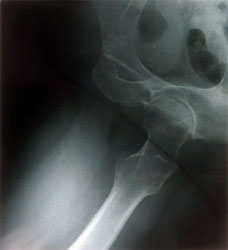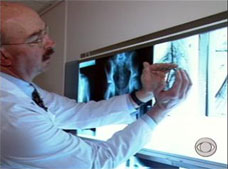|
What is Bone Cancer ?
Bone cancer is triggered off
when there is a disorder of the cells that bones are made up of.
If the cancer starts in the bone, it is known as primary bone
cancer.
Various
Types of Bone Cancer
Bones serve various purposes in the body. They protect and support
the organs in the body. For instance, the brain is protected by
the skull and the lungs are protected by the ribs. Blood cells are
made and stored in the bone marrow, the spongy and soft tissue
that many bone have in their center.
Primary bone cancer occurs most commonly in the legs and arms,
although it can also affect other bones of the body. Primary bone
cancers are usually referred to as sarcomas, of which there are
several types. Each type of sarcoma affects a different type of
bone tissue, with the most common being: chondrosarcoma; Ewing’s
sarcoma; and osteosarcoma.
Chondrosarcoma: This type of bone cancer occurs mostly in adults.
It affects the cartilage, which is the rubber-like tissue that is
around the joints.
Ewing's sarcoma: This bone cancer occurs most often amongst people
between the ages of 10-25, with teenagers being most affected. It
affects the shaft, or middle part of large bones. It usually
occurs in the long bones of the upper arm and thigh and also the
hipbones. It can also affect the ribs.
Osteosarcoma: This is the most common kind of bone cancer and it
affects young people in the age group of 10-25 years. Males are
more susceptible to it compared to females. Osteosarcoma usually
begins where new bone tissue forms, at the ends of bones, as young
people grow. The long bones of the legs and arms are usually
affected by it.
Cancers like the above, which start in the bone, occur rarely.
However, it is quite common for cancers to spread from the other
parts of the body to the bone. This type of cancer is known as
metastatic cancer. Around 80% of the metastatic cancers that
affect the bone are due to primary carcinomas that affect other
organs such as the prostate, breast, kidney, lung, stomach,
pancreas, and thyroid. Each of these types of metastatic cancers,
which affect the bone, is named according to the tissue or organ
where the primary cancer occurs.
What are the Bone Cancer Symptoms?
The symptoms of bone cancer vary from one person to another
according to the location and size of the bone cancer. Pain is one
of the most common bone cancer symptoms. Generally, there is a
gradual increase in the severity of the symptoms with time. At
first, the pain may only be felt with activity or at night.
According to the growth of the cancerous tumor, people may
experience the symptoms for weeks, perhaps even months, sometimes
even years until they seek medical help. Sometimes a lump or mass
may occur either in the tissues that surround the bone or on the
bone itself. This commonly occurs with fibrosarcoma or MFH, but
can also occur with other types of bone tumors as well. Some of
the less common bone cancer symptoms are weight loss, night
sweats, chills, and fever. These symptoms usually occur when the
cancerous tumor spreads to the other parts of the body.
Various factors affect the successful treatment of bone cancer,
one of the most important being the early detection of the
symptoms of bone cancer. Moreover, the recovery from this disease
is largely dependent on the recognition and understanding of bone
cancer symptoms. These symptoms are actually signs warning that
something could be wrong. Hence, these symptoms of bone cancer
should not be ignored. And, even though the symptoms may
ultimately prove to be the root causes of some other ailment, it
is better to make certain and not ignore these bone cancer
symptoms.
what is the
diagnosis?
As with most illnesses, the first part of the diagnosis of
suspected bone cancer is a discussion with the doctor about the
patient's personal and family medical history. Then the doctor
performs a complete medical examination and conducts various
tests.
Laboratory Tests
One key test is an examination of a patient's blood for alkaline phosphatase, an enzyme that can be found at particularly high
levels in the blood when bone-forming cells are very active. This
kind of high activity occurs normally when a young child's bones
are growing, or when a broken bone is mending. Otherwise, it might
be an indication that a tumor is creating abnormal bone tissue.
Since alkaline phosphatase may rise in response to other causes,
high levels don't necessarily indicate whether a patient has bone
cancer, but they do signal the need for further evaluation.
Imaging Tests
A physician will usually order imaging tests such as an x-ray,
which will allow the doctor to see any unusual bone growths. This
may be followed by a bone scan, to see if there are other abnormal
areas in the skeleton. Before a bone scan, a small amount of
"tracer" material is injected into a vein. After a few hours, this
tracer material, which is slightly radioactive, collects in places
where there is new bone growth. A CT (computed tomography) or MRI
(magnetic resonance imaging) scan is often ordered to show the
exact size and shape of the suspected bone tumor, and to determine
if it has invaded surrounding tissue or the bone marrow space.
Biopsy
Finally, a biopsy of the suspicious bone tissue is needed to make
a definite diagnosis. If the tumor is small enough, the doctor may
remove the entire tumor, then analyze samples of it under a
microscope to see if it is cancerous. This procedure is called an
"excisional biopsy." In other cases, the doctor may make a small
opening in the skin and remove just a small part of the tumor for
analysis -- an "open biopsy." Or the doctor may do a needle
biopsy, in which a sample of the tumor is removed through the skin
using a needle. It is important that the biopsy be performed by an
experienced and skilled surgeon, because an improperly performed
biopsy may limit treatment options later.
A pathologist examines the biopsy samples to determine whether or
not the tissue is cancerous, and if it is, to identify the exact
type of cancer. Determining the exact type of cancer is critical,
because not all types of bone cancer respond to the same types of
treatment.
Though surgical resection remains the mainstay of treatment in
musculoskeletal tumors it is uncommon for a patient with a high
grade sarcoma to be treated by surgery alone. Adjuvant modalities
like chemotherapy and radiotherapy play an essential part in the
integrated management of these patients. A majority of bone tumors
would receive chemotherapy while some like Ewing's sarcoma would
benefit from additional radiotherapy.
Surgery
Surgery is used to remove the bone cancer itself. When operating
to remove bone tumors, surgeons remove some of the surrounding
bone and muscle to be sure that they are removing as much
cancerous tissue as possible. If the operation is on an arm or
leg, the surgeon will try , as much as possible, to preserve the
limb and maintain its fnctionality. Sometimes the bone that is
removed will be replaced with bone from another part of the body,
bone from the tissue bank or with an artificial replacement.
Radiation Therapy
Radiation therapy is sometimes given together with surgery, to
destroy tumors or to reduce the size of the tumor. Radiation
therapy may also be used to kill remaining cancer cells after
surgery, or treat tumors that cannot be surgically removed --
sometimes in combination with chemotherapy.
Chemotherapy
Chemotherapy is often used to treat primary bone cancers, in
conjunction with surgery. Chemotherapy is commonly given before
surgery to facilitate surgery and also after surgery to kill any
cancer cells that remain in the body after the main tumor is
removed surgically
Osteosarcoma
Once tissue diagnosis is made, chemotherapy is advised.
Chemotherapy is given both before and after surgery . Adriamycin,
cisplatinum, ifosfamide and etoposide are the effective drugs
against osteosarcoma.
Ewing's family of Tumors
Like in osteosarcoma, multiagent chemotherapy improves overall
survival. Ifosfamide,etoposide, vincristine, adriamycin,
cyclophosphamide and actinomycin-D are the agents used. Radiation
had earlier been the preferred method of local control but the
role of surgery is now being established. Recent reports indicate
that surgery combined with chemotherapy and with or without
radiation may have better local control rates than chemotherapy
with radiation alone.
|





